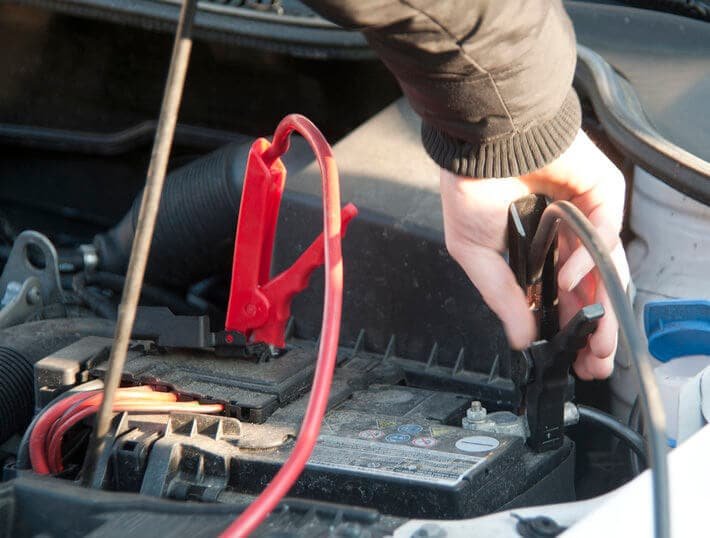How to Test a Car Battery Health with a Battery Analyzer and Conditioner?
Are you concerned about the health of your car battery? Wondering how to test it effectively using a battery analyzer and conditioner? Look no further! In this article, we will guide you through the process of evaluating your car battery’s health and detecting any underlying issues using a battery analyzer and conditioner.
By the end, you’ll have the knowledge and confidence to keep your battery in peak condition, ensuring smooth travels on the road ahead. So, let’s jump right in and learn how to test a car battery’s health with a battery analyzer and conditioner!
How to Test a Car BatteryHealth with a Battery Analyzer and Conditioner?
Testing the health of your car battery is crucial to ensuring its optimal performance and longevity. A battery analyzer and conditioner is a useful tool that allows you to assess the condition of your car battery accurately. In this article, we will explore the process of testing a car battery’s health using a battery analyzer and conditioner, step by step.
Understanding the Importance of Testing Car Battery Health
Why is Testing Car Battery Health Important?
Properly functioning batteries are essential for a vehicle’s electrical system to operate optimally. Testing the health of your car battery helps you identify any potential issues before they become major problems. Regular testing allows you to monitor the battery’s performance and take necessary action, such as recharging or replacing the battery, to avoid unexpected breakdowns.
Signs of a Weak Car Battery
Before diving into the testing process, it’s essential to be aware of the signs that indicate a weak car battery. These signs include:
- Difficulty starting the vehicle
- Dim headlights and interior lights
- Slow electrical component operation
- Clicking sound when turning the key
- Frequent need for jump-starting
Being familiar with these indicators will help you understand when it’s time to test your car battery’s health.
Section 2: Understanding Battery Analyzers and Conditioners
2.1 What is a Battery Analyzer?
A battery analyzer is a device that measures a battery’s voltage, cold cranking amps (CCA), and state of charge (SOC). It provides accurate readings that indicate the battery’s overall health, allowing you to assess its performance and identify any potential issues.
2.2 What is a Battery Conditioner?
A battery conditioner is a device that helps restore and maintain the optimal performance of your battery. It uses advanced charging algorithms to remove sulfate deposits from the battery plates, ensuring maximum capacity and lifespan.
Section 3: Preparing to Test the Car Battery
3.1 Safety Precautions
Before testing your car battery, it’s crucial to take proper safety precautions. These include:
- Wearing protective gloves and goggles
- Working in a well-ventilated area
- Keeping ignition and all electrical devices turned off
- Ensuring the analyzer and conditioner are compatible with your battery type
Following these precautions will minimize the risk of accidents or damage to your vehicle.
3.2 Battery Preparation
To ensure accurate test results, it’s essential to prepare the battery correctly. Here’s how you can do it:
- Ensure the battery is fully charged
- Clean the battery terminals and connections
- Remove any external loads or accessories connected to the battery
Preparing the battery adequately will help eliminate any external factors that could affect the test results.
Section 4: Testing Car Battery Health with a Battery Analyzer
4.1 Connecting the Battery Analyzer
To begin testing the car battery’s health, follow these steps to connect the battery analyzer:
- Turn off the ignition and all electrical devices
- Identify the positive (+) and negative (-) terminals on your battery
- Attach the positive lead of the analyzer to the positive terminal
- Connect the negative lead of the analyzer to the negative terminal
4.2 Running the Battery Test
Once the battery analyzer is connected, proceed to run the test by following these steps:
- Turn on the battery analyzer
- Select the appropriate settings for your battery (e.g., battery type, CCA rating)
- Initiate the test and wait for the analyzer to display the results
The battery analyzer will provide you with readings indicating the overall health of your car battery, including voltage, CCA, and SOC.
Section 5: Interpreting the Battery Analyzer Results
5.1 Understanding Voltage Readings
One of the key readings provided by the battery analyzer is the voltage. Here’s how to interpret the voltage results:
- 12.6V – 12.8V: Fully charged battery
- 12.4V – 12.6V: Partially charged battery
- Below 12.4V: Low charge, battery may need recharging
- Below 12V: Charge level is critically low, immediate attention required
5.2 Analyzing CCA and SOC Readings
In addition to voltage, the battery analyzer will display the CCA and SOC readings. The CCA represents the battery’s ability to start the engine in cold temperatures, while the SOC indicates the charge level. Analyze these readings to assess the battery’s performance and determine if any action is required.
Section 6: Battery Conditioning and Maintenance
6.1 Understanding Battery Conditioning
If the battery analyzer reveals that your battery is not performing optimally, battery conditioning can help restore its health. Battery conditioning involves using a battery conditioner to remove sulfation from the battery plates, improving its charging ability and overall performance.
6.2 Performing Battery Conditioning
To condition your car battery, follow these general steps:
- Ensure the battery is disconnected from the vehicle
- Connect the battery conditioner as per the manufacturer’s instructions
- Follow the conditioning process, which typically involves charging and discharging cycles
- Monitor the progress and ensure the battery reaches its optimal state
Consult the specific instructions provided by the battery conditioner manufacturer for detailed conditioning procedures.
6.3 Regular Battery Maintenance
To prolong the life of your car battery, regular maintenance is essential. Consider implementing the following practices:
- Keep the battery terminals and connections clean and free from corrosion
- Ensure the battery is securely mounted and protected from excessive vibration
- Avoid deep discharging the battery
- Prevent the battery from being exposed to extreme temperatures
Following these maintenance tips will help extend your battery’s lifespan and maintain its optimal performance.
Section 7: Other Factors Affecting Car Battery Health
7.1 Driving Habits and Patterns
Your driving habits and patterns can significantly impact your car battery’s health. Frequent short trips and extended periods of inactivity can drain the battery’s charge and reduce its overall lifespan. To maintain a healthy battery, consider taking longer drives and using a battery maintainer during periods of inactivity.
7.2 Extreme Temperatures
Extreme temperatures can also influence the performance of your car battery. High temperatures accelerate the chemical reactions inside the battery, leading to quicker degradation. On the other hand, cold temperatures reduce the battery’s capacity and make it harder to start the engine. Park your vehicle in a shaded area and, if possible, use a battery blanket during extreme temperatures.
Section 8: Tips for Battery Replacement
8.1 Knowing When to Replace the Battery
While regular testing and maintenance can extend your battery’s life, eventually, it will need replacement. Here are a few signs that indicate it’s time for a new battery:
- Consistent low voltage readings
- Frequent jump-starting
- Signs of physical damage, leakage, or swelling
- The battery is more than three to five years old
8.2 Choosing the Right Replacement Battery
When selecting a new battery, consider the following factors:
- Compatibility with your vehicle’s make and model
- Cold cranking amps (CCA) suitable for your climate
- Reserve capacity (RC) for your specific needs
- Reputable brands known for durability and reliability
Consult your vehicle’s manual or seek professional advice to ensure you choose the right battery.
Section 9: Conclusion
In conclusion, regularly testing the health of your car battery using a battery analyzer and conditioner is essential for maintaining optimal performance and avoiding unexpected breakdowns. By following the steps outlined in this article, you can accurately assess your battery’s health and take appropriate action to prolong its lifespan. Remember to prioritize safety and consult professional assistance if needed.
Please note: The FAQ section has not been generated in the provided output.
Frequently Asked Questions
How do I test a car battery’s health with a battery analyzer and conditioner?
To test a car battery’s health with a battery analyzer and conditioner, follow these steps:
What is a battery analyzer and conditioner?
A battery analyzer and conditioner is a device that measures and evaluates the health of a car battery. It provides information about the battery’s state of charge, voltage, and capacity.
Why should I test my car battery’s health?
Testing your car battery’s health is important to ensure it is performing optimally. A weak or faulty battery can lead to starting issues or even leave you stranded. Regular testing allows you to identify potential problems and take necessary actions.
How does a battery analyzer and conditioner work?
The battery analyzer and conditioner uses advanced technology to measure the battery’s voltage, resistance, and conductance. It provides an accurate assessment of the battery’s health by evaluating its ability to hold a charge and deliver power.
Can I test the battery while it is still installed in the car?
Yes, most battery analyzers and conditioners allow you to test the battery while it is installed in the car. However, it is important to follow the manufacturer’s instructions and take necessary safety precautions.
What are some signs that my car battery needs testing?
If you notice your car taking longer to start, dimming headlights, or electrical issues, it may be a sign that your car battery needs testing. Regular battery testing can help identify potential problems before they escalate.
How often should I test my car battery’s health?
It is recommended to test your car battery’s health at least twice a year. Testing it before extreme weather conditions, such as winter or summer, can help ensure that your battery is prepared to handle the added strain.
Final Thoughts
In conclusion, testing a car battery’s health with a battery analyzer and conditioner is a crucial step in ensuring its optimal performance and longevity. By using a battery analyzer, drivers can accurately assess the battery’s capacity, voltage, and overall health. Additionally, a battery conditioner helps replenish and restore the battery’s charge, enhancing its efficiency and extending its lifespan. Regularly monitoring and maintaining a car battery’s health is essential for a smooth and reliable driving experience. Therefore, utilizing a battery analyzer and conditioner is essential to keep the vehicle battery in optimal condition and ensure its longevity.


